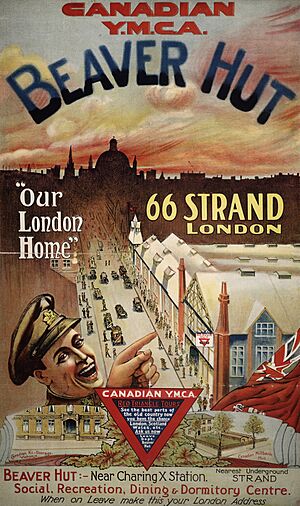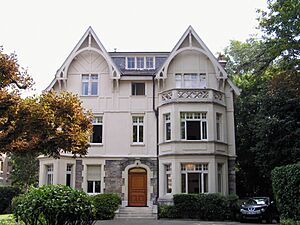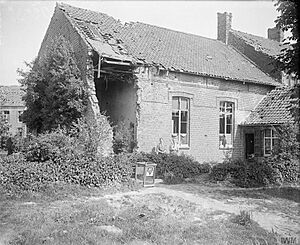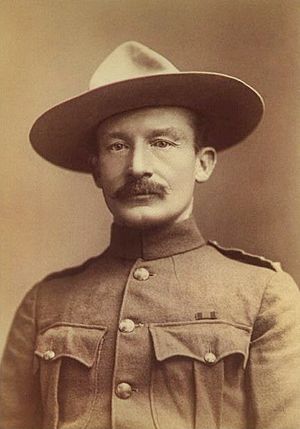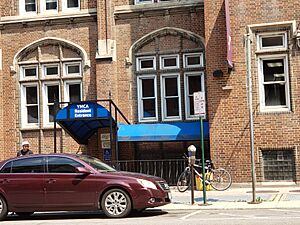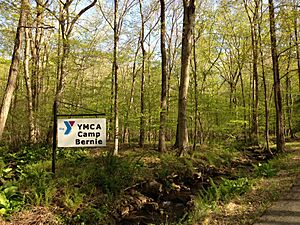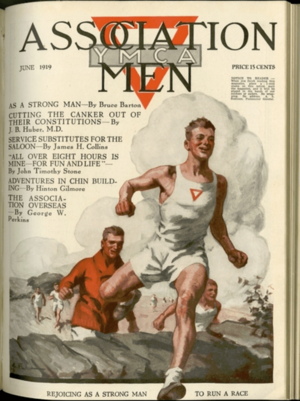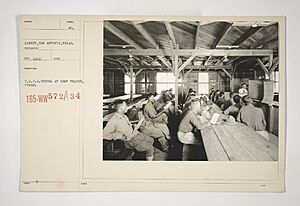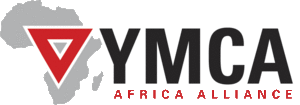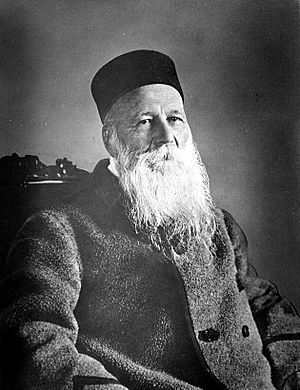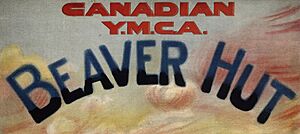YMCA facts for kids
 |
|
| Founded | 6 June 1844 |
|---|---|
| Founder | George Williams |
| Founded at | London, England |
| Type | International NGO |
| Headquarters | Vernier, Canton of Geneva, Switzerland |
|
Region served
|
Worldwide |
|
President
|
Soheila Hayek |
|
Secretary General
|
Carlos Sanvee |
|
Staff
|
88,485 (2018) |
|
Volunteers
|
919,671 (2018) |
|
Formerly called
|
Young Men's Christian Association |
The YMCA, also known as the Y, is a huge worldwide group for young people. It started in London, England, on June 6, 1844. A man named George Williams and his friends created it. They called it the Young Men's Christian Association.
The main goal of the YMCA is to help young people grow in a healthy way. This means taking care of their body, mind, and spirit. Today, the YMCA helps over 64 million people in 120 countries. It has nearly 90,000 staff and about 920,000 volunteers. You might know the YMCA from the famous 1978 song "Y.M.C.A." by the Village People.
| Top - 0-9 A B C D E F G H I J K L M N O P Q R S T U V W X Y Z |
History of the YMCA
How the YMCA Started
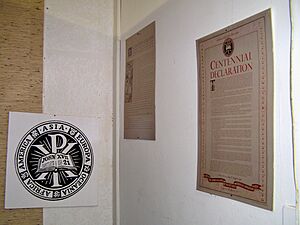

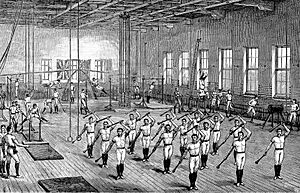
The YMCA began on June 6, 1844. George Williams and eleven friends started it. George was a worker in London. He and his friends were worried about young men in big cities. There were not many good places for them to go.
George's idea came from prayer and Bible-reading meetings. He held these meetings with his co-workers. The first YMCA aimed to help young men grow in their faith. It also helped them in their daily lives. The first YMCA building opened in London in 1844.
The YMCA grew very quickly. It became a worldwide movement. It focused on helping people develop their spirit, mind, and body. This idea was called "muscular Christianity." Local YMCAs offered many activities for young people. These included sports, classes, and community work.
The YMCA spread outside the UK after 1851. This was helped by the Great Exhibition in London. Soon, YMCAs were in Australia, Canada, France, Germany, and the United States.
A Global Movement
Henry Dunant helped make the YMCA a global group. He was the Secretary of YMCA Geneva. He later started the International Committee of the Red Cross. Dunant helped organize the first YMCA World Conference in 1855.
Delegates from nine countries met in Paris. They decided to work together more closely. This started the World Alliance of YMCAs. They agreed on a common mission called the Paris Basis. Their motto was "That they all may be one" from the Bible.
In 1865, the YMCA stressed developing the whole person. This meant spirit, mind, and body. Sports became an important part of this idea. The Boy Scouts of America even grew from YMCA work.
The World YMCA offices moved to Geneva, Switzerland, in 1878. In 1880, Norway's YMCA made a rule for equal gender representation. This meant men and women had equal roles in committees. In 1885, the first overnight camp in North America started. It was called Camp Baldhead, later Camp Dudley.
The 20th Century
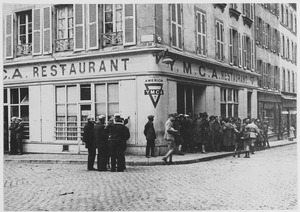


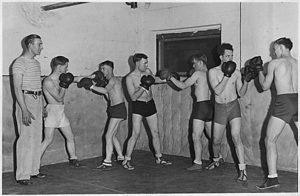
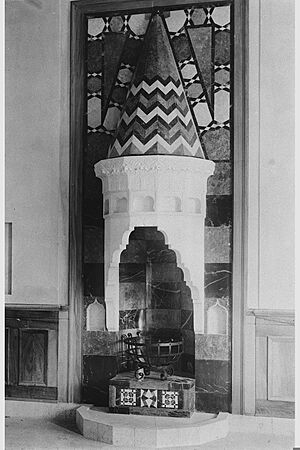
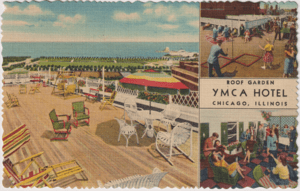
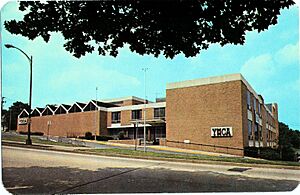
The YMCA helped start Boy Scout groups in the UK from 1907. YMCA workers helped organize these early troops. Later, when Robert Baden-Powell formed his own Scout organization, YMCA leaders helped him.
During World War I, the YMCA set up recreation centers. These were called "huts" for soldiers and civilians. They also helped prisoners-of-war. Famous people like Clementine Churchill volunteered. The YMCA spent over $155 million helping American soldiers.
In World War II, the YMCA supported millions of prisoners of war. They also helped Japanese Americans in internment camps. The YMCA was one of seven groups that started the USO. In Europe, the YMCA helped refugees, especially displaced Jewish people.
In 1947, the World YMCA started working with the United Nations Economic and Social Council. In 1955, Charles Dunbar Sherman from Liberia became the first black President of the World YMCA. He was also the youngest at 37. In 1959, YMCA of the USA created the first national scuba diving course.
In 1973, the World Council met in Uganda. It confirmed the Paris Basis. It also adopted the Kampala Principles. These included justice, creativity, and honesty. The YMCA recognized it needed to take stands on global issues.
In 1976, Violet King Henry became the first woman in a senior management role at the American YMCA. In 1985, the World Council spoke out against apartheid. In 1998, "Challenge 21" was adopted. This focused on global issues like gender equality and sustainable development.
The 21st Century
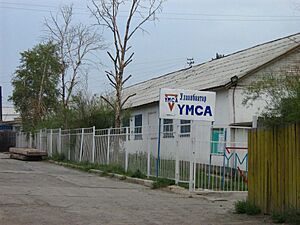
In 2002, the World Council asked for peace in the Middle East. On July 12, 2010, YMCA of the USA changed its name to "The Y." They also updated their logo. Today, YMCAs welcome everyone. This includes people of all ages, backgrounds, and beliefs.
In 2018, Carlos Sanvee from Togo became the first African Secretary General of World YMCA. Patricia Pelton from Canada became the first female President. In 2019, the YMCA celebrated its 175th anniversary. A big event in London brought together 3,200 young leaders. They celebrated youth leadership and the United Nations Sustainable Development Goals.
London Central YMCA Building
In December 2024, the Central YMCA building in London was sold. This building was the first YMCA in the world. The YMCA said it was due to high costs. Many members and the public were upset. A petition to stop the sale got thousands of signatures.
The Central YMCA was a key part of the community. It had a pool, gym, and studios. It was the largest YMCA in London. However, the building closed on February 7, 2025. The YMCA stated that its other services would continue.
People criticized the property company that bought the site. They felt it focused on business over community needs. A "Save the YMCA" campaign started. It aimed to keep the facilities open. The campaign got media attention. It highlighted worries about losing community resources.
Critics argued the sale went against the YMCA's mission. They urged the new owners to work with them. They hoped to keep the building serving the community. A "Save the ExCYMCA" campaign was also started. They hoped the building could return to YMCA use.
How the YMCA is Organized Globally

The YMCA has its main office in Vernier, Switzerland. It moved there in 2020 from Geneva. The YMCA works like a federation. This means each local YMCA is independent. But they are all connected to their national organization.
National organizations are part of a regional group. These include Europe, Asia Pacific, and North America. All these groups are part of the World YMCA. The World YMCA is the highest body. Each part of the YMCA is independent. But they work together on projects.
The World YMCA holds a big meeting every few years. It's called the World Council. This meeting sets the goals for the World YMCA. It also elects leaders. The most recent World Council was in 2022 in Denmark. The next one is planned for July 2026 in Canada.
YMCA Activities and Services
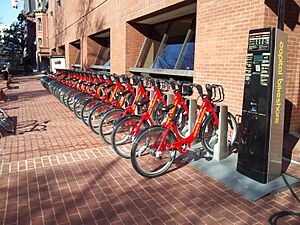
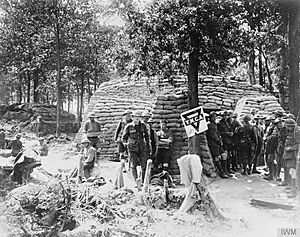

Places to Stay
YMCAs around the world offer different types of places to stay. Some have budget rooms like youth hostels or hotels. These help fund other YMCA activities. In England and Wales, YMCAs offer housing for young people who are homeless.
Until the 1950s, YMCAs in the US had hotel-like rooms. These were for young men moving to cities. They were safe and cheap places to stay. By 2006, YMCAs with these rooms were less common. But some still exist.
Arts and Learning
YMCAs offer classes in many arts. These include drawing, painting, and photography. They also have music, dance, and poetry. Some YMCAs offer reading and storytelling. These programs give kids a safe place to enjoy creative activities.
Many colleges and universities have ties to the YMCA. Springfield College was founded to train YMCA professionals. Northeastern University started from a YMCA in Boston. The YMCA also pioneered "night school." This helped people with full-time jobs get an education.
Many YMCAs offer English classes for new speakers. They also have alternative high school programs. Day care and summer camps are common too. The Y Learning program helps students who need extra help with homework.
Camps and Family Programs
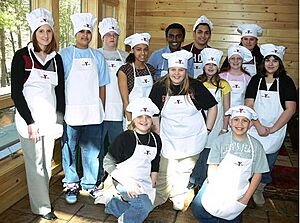
YMCA camping started in 1885. Camp Baldhead was the first overnight camp in North America. It was later called Camp Dudley. Canada also had early YMCA camps.
YMCAs offer child care for infants and toddlers. Parents can work out while their children play safely. YMCA staff are trained to keep children safe.
Family programs include family nights and parent-child classes. The Y-Guides program helps parents and children bond. They do activities like camping and crafts. YMCA after-school programs help students develop skills. These include recreational, cultural, and social skills.
Health and Sports
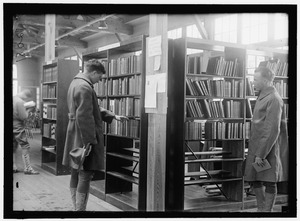
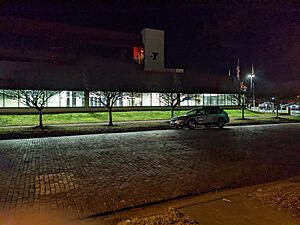
The YMCA is famous for inventing sports. In 1891, James Naismith invented basketball at a YMCA school. He needed a new indoor game for students. It had to be fun and easy to learn.
In 1895, William G. Morgan invented volleyball at a YMCA. He wanted a slower game for older members. In 1930, Juan Carlos Ceriani invented futsal. This is an indoor version of soccer.
YMCAs also have fitness and wellness programs. The Diabetes Prevention Program helps people live healthier lives.
Aquatics
YMCAs offer many water activities. These include swimming classes for all ages. They have classes for babies, kids, teens, and adults. Some YMCAs have special Olympic swim teams. You can also take water polo lessons.
Gymnastics
Gymnastics started at the YMCA in 1869. Early YMCA gyms had gymnastics equipment. Today, YMCAs offer gymnastics for boys and girls. They have equipment like parallel bars and balance beams. Many YMCAs offer gymnastics camps and teams.
Racquetball
Racquetball is another sport invented at the YMCA. Joseph Sobek created it in 1950. He wanted an indoor sport that was different from tennis or handball. He designed a short racquet and used a rubber ball. He called it "paddle rackets."
YMCA Around the World
Africa

YMCAs in Africa are part of the Africa Alliance of YMCAs (AAYMCA). Their main goal is to help young people grow strong. The AAYMCA is the oldest non-government group in Africa. It helps about five million people. The first YMCA in Africa started in Liberia in 1881.
Asia

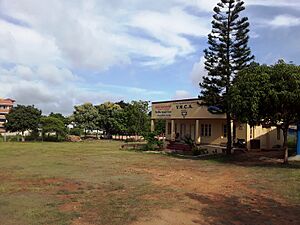
China
In 1911, J. Howard Crocker helped the YMCA in China. He worked to promote physical education. He set up the first school for physical education directors in China.
Hong Kong
YMCA Hong Kong started in 1901. It later split into two groups. One was "YMCA of Hong Kong" and the other "Chinese YMCA of Hong Kong". YMCA Hong Kong has been at its current location since 1922.
Europe
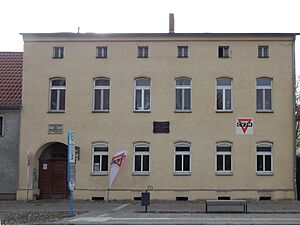
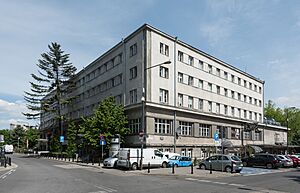
Germany
In Germany, the YMCA is called CVJM. This stands for "Christian Association of Young People." Until 1985, it was "Christian Association of Young Men." The name changed to include both men and women.
Sweden
The YWCA-YMCA of Sweden started in 1966. It combined the YMCA and YWCA groups. In 2011, they started using "KFUM Sverige." The "M" now means "people" instead of "men." This shows they include everyone.
United Kingdom and Ireland

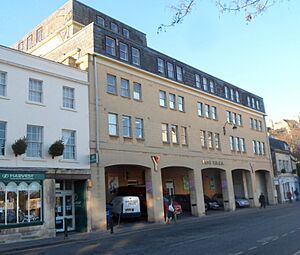
The YMCA in the United Kingdom and Ireland has three main groups. These are for England and Wales, Ireland, and Scotland. In 2017, YMCAs in Wales joined YMCA England.
YMCAs in England and Wales help young people who need homes. They also offer mental health services and youth clubs. They have sports centers, nurseries, and family support. In 2024, they helped over 18,000 young people with homes. Many YMCAs also offer gyms, pools, and cafes to the community.
Latin America
Argentina
The YMCA started in Argentina in 1902. It helped train physical education teachers. The YMCA was important in promoting women's sports. They encouraged basketball, swimming, and track and field.
Brazil
The YMCA began in Brazil in 1893. Volleyball was seen as a good sport for women from the start. The YMCA helped promote women's volleyball in schools.
Mexico
Mexico's first YMCA opened in Mexico City in 1902. It offered physical activities and helped young men learn life skills. The YMCA also had activities for women.
Panama
In 1904, the YMCA was brought to the Panama Canal Zone. They built clubhouses with billiard rooms, reading rooms, and gyms. These helped workers and their families. Panama YMCA was officially founded on May 24, 1966. It continues to work for a better society. In 2005, YMCA Panama opened a new school.
Peru
YMCA Peru started on May 17, 1920. It has staff and volunteers who work to help young people. Their goal is to help young people make positive changes in Peruvian society.
Middle East
Israel
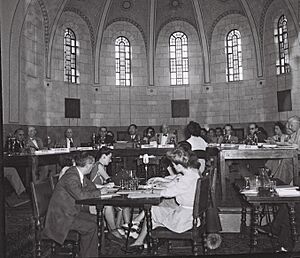
The Jerusalem YMCA building was opened in 1933. It was built to be a place of peace. It aimed to help people forget differences and work together. It had the city's first heated pool and gym.
In 1947, the YMCA hosted important talks for the UN Partition Plan. In 1948, the building was used by the International Red Cross to shelter refugees. It was returned to the YMCA in 1949.
Gaza
The YMCA in Gaza City started in 1952. It was part of the Egypt YMCA. After 1967, it became independent. Gaza YMCA has departments for sports, arts, and youth. Most people who attend are Muslim. The staff includes both Muslims and Christians. The YMCA teaches young people about religious tolerance. In 2021, Gaza's YMCA helped 1,800 young people.
In late 2023, the YMCA in Gaza was used as a shelter. Hundreds of people stayed there during attacks. On December 17, 2023, the building was hit and destroyed. The World YMCA strongly spoke out against this attack.
West Bank
There are four YMCA places in the West Bank. Two are in East Jerusalem. One is in Beit Sahour, and one in Ramallah. In 1948, the first YMCA in East Jerusalem started in a refugee camp. It helped refugees learn skills. It also offered sports and youth programs.
The facilities moved to East Jerusalem. They helped the community during the 1967 war. In Beit Sahour, they started a program for people with disabilities. This program is still helping people today.
North America
Canada
The first YMCA in North America opened in Montreal, Quebec, on November 25, 1851. As of 2024, Canada has 35 YMCAs. They help 2.25 million people each year. Programs include child care, camps, and health activities. They also help newcomers and offer leadership training.
United States

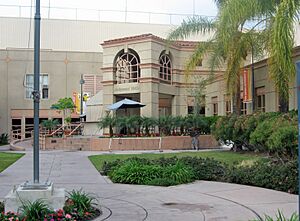

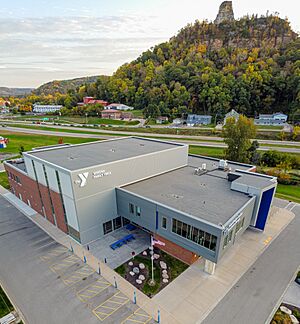
In the United States, the YMCA is often called 'The Y'. Its main office is in Chicago. It has 800 groups and 2,700 locations. They work with 21 million people. Their goal is to make communities stronger. They focus on youth development, healthy living, and social responsibility.
Major programs include after-school activities and day care. They also have youth work and fitness programs. Many locations have gyms, pools, and sports courts.
The first YMCA in the United States opened in Boston, Massachusetts, on December 29, 1851. It was founded by Captain Thomas Valentine Sullivan. In 1853, Reverend Anthony Bowen started the first YMCA for African American men in Washington, D.C.. The YMCA in the USA is one of the largest charities.
Nobel Peace Prize Winners
- 1901: Henry Dunant, who helped start the Geneva YMCA and the World YMCA, won the first Nobel Peace Prize. He won for starting the International Committee of the Red Cross.
- 1946: John R. Mott, who was president of the World YMCA, won the Nobel Peace Prize. He won for bringing people from many nations and backgrounds together.
YMCA Logo
In 1881, the World Alliance of YMCAs adopted its official emblem. It is a circle with five parts, one for each continent. Small YMCA symbols in different languages hold the parts together. In the middle is a larger symbol of Christ's name. An open Bible sits on top. It shows the verse "that they all may be one." This reminds YMCAs that faith is at their center.
In 1891, Luther Gulick introduced a new YMCA symbol. It was an upside-down red triangle. Gulick said the triangle stood for "the whole person." This meant mind, body, and spirit. This logo became well-known during World War I and II. It is still used today.
In 2010, YMCA of the USA changed its logo to "The Y." This was part of a bigger brand change.
YMCA Vision 2030
In 2022, the global YMCA adopted a new plan called YMCA Vision 2030. This plan helps YMCAs set their goals. It is closely linked to the UN Sustainable Development Goals. As of June 2023, 75 YMCA groups were working on this plan.
|
See also
 In Spanish: Asociación Cristiana de Jóvenes para niños
In Spanish: Asociación Cristiana de Jóvenes para niños



